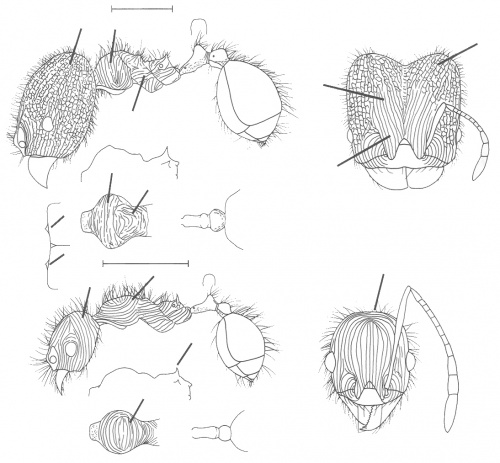Pheidole ectatommoides
| Pheidole ectatommoides | |
|---|---|

| |
| Scientific classification | |
| Kingdom: | Animalia |
| Phylum: | Arthropoda |
| Class: | Insecta |
| Order: | Hymenoptera |
| Family: | Formicidae |
| Subfamily: | Myrmicinae |
| Tribe: | Attini |
| Genus: | Pheidole |
| Species: | P. ectatommoides |
| Binomial name | |
| Pheidole ectatommoides Wilson, 2003 | |
Longino (1997) discovered workers foraging at night on the ground and on a fallen branch in a forest. At several localities across the range, caches of seeds have been found in the nests. (Wilson 2003)
Photo Gallery
Identification
See the description in the nomenclature section.
Keys including this Species
Distribution
Recorded from Costa Rica, Panama, Colombia, and Ecuador. J. T. Longino (1997) found the species in Costa Rica on the Atlantic slope. (Wilson 2003)
Latitudinal Distribution Pattern
Latitudinal Range: 10.35° to -2.702505°.
| North Temperate |
North Subtropical |
Tropical | South Subtropical |
South Temperate |
- Source: AntMaps
Distribution based on Regional Taxon Lists
Neotropical Region: Colombia, Costa Rica (type locality), Ecuador, Panama.
Distribution based on AntMaps
Distribution based on AntWeb specimens
Check data from AntWeb
Countries Occupied
| Number of countries occupied by this species based on AntWiki Regional Taxon Lists. In general, fewer countries occupied indicates a narrower range, while more countries indicates a more widespread species. |

|
Estimated Abundance
| Relative abundance based on number of AntMaps records per species (this species within the purple bar). Fewer records (to the left) indicates a less abundant/encountered species while more records (to the right) indicates more abundant/encountered species. |

|
Biology
Castes
Worker
Minor
Images from AntWeb
  
| |
| Worker. Specimen code casent0635461. Photographer J. Longino, uploaded by University of Utah. | Owned by JTLC. |
Nomenclature
The following information is derived from Barry Bolton's Online Catalogue of the Ants of the World.
- ectatommoides. Pheidole ectatommoides Wilson, 2003: 683, figs. (s.w.) COSTA RICA.
Unless otherwise noted the text for the remainder of this section is reported from the publication that includes the original description.
Description
DIAGNOSIS A highly distinctive species with some resemblance to Pheidole arietans, Pheidole glyphoderma and Pheidole triumbonata, but instantly recognizable by the unique pattern of sculpturing, especially on the minor worker, as illustrated.
MEASUREMENTS (mm) Holotype major: HW 1.98, HL 2.12, SL 0.90, EL 0.24, PW 0.86. Paratype minor: HW 0.74, HL 0.80, SL 0.84, EL 0.20, PW 0.50. ectatommoides COLOR Major: head, meso soma, and waist light reddish brown; appendages and gaster reddish yellow.
Minor: head and meso soma reddish yellow; waist, gaster, and appendages plain medium yellow.
Figure. Upper: holotype, major. Lower: paratype, minor. Scale bars = 1 mm.
Type Material
COSTA RICA: Rio Toro Amarillo, near Guapiles, col. William L. Brown. Museum of Comparative Zoology
Etymology
L ectatommoides, referring to the distinctive sculpturing of the minor especially, reminiscent of ectatommoid ponerine ants.
References
- Wilson, E. O. 2003. Pheidole in the New World: A dominant, hyperdiverse ant genus. Harvard University Press, Cambridge, MA. (page 683, fig. major, minor described)
References based on Global Ant Biodiversity Informatics
- Fernández, F. and S. Sendoya. 2004. Lista de las hormigas neotropicales. Biota Colombiana Volume 5, Number 1.
- Longino J. T. L., and M. G. Branstetter. 2018. The truncated bell: an enigmatic but pervasive elevational diversity pattern in Middle American ants. Ecography 41: 1-12.


